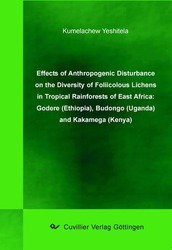| Departments | |
|---|---|
| Book Series (96) |
1378
|
| Nachhaltigkeit |
3
|
| Gesundheitswesen |
1
|
| Humanities |
2363
|
| Natural Sciences |
5406
|
| Mathematics | 229 |
| Informatics | 319 |
| Physics | 980 |
| Chemistry | 1363 |
| Geosciences | 131 |
| Human medicine | 243 |
| Stomatology | 10 |
| Veterinary medicine | 108 |
| Pharmacy | 147 |
| Biology | 835 |
| Biochemistry, molecular biology, gene technology | 121 |
| Biophysics | 25 |
| Domestic and nutritional science | 45 |
| Agricultural science | 1004 |
| Forest science | 201 |
| Horticultural science | 20 |
| Environmental research, ecology and landscape conservation | 148 |
| Engineering |
1791
|
| Common |
98
|
|
Leitlinien Unfallchirurgie
5. Auflage bestellen |
|
Advanced Search
Effects of nithropogenic disturbance on the diversity of foliicolous lichens in tropical rainforests of East Africa: Godere (Ethiopia), Budongo (Uganda) and Kakamega (Kenya) (English shop)
Kumelachew Yeshitela (Author)Preview
Table of Contents, Datei (27 KB)
Extract, Datei (74 KB)
Foliicolous lichens are one of the most abundant epiphytes in tropical rainforests and one
of the few groups of organisms that characterize these forests. Tropical rainforests are
increasingly affected by anthropogenic disturbance resulting in forest destruction and
degradation. However, not much is known on the effects of anthropogenic disturbance on
the diversity of foliicolous lichens. Understanding such effects is crucial for the
development of appropriate measures for the conservation of such organisms.
In this study, foliicolous lichens diversity was investigated in three tropical rainforests in
East Africa. Godere Forest in Southwest Ethiopia is a transitional rainforest with a mixture
of Afromontane and Guineo-Congolian species. The forest is secondary and has been
affected by shifting cultivation, semi-forest coffee management and commercial coffee
plantation. Budongo Forest in West Uganda is a Guineo-Congolian rainforest consisting of
primary and secondary forests. Kakamega Forest in western Kenya is a transitional
rainforest with a mixture of Guineo-Congolian and Afromontane species. The forest is a
mosaic of near-primary forest, secondary forests of different seral stages, grasslands,
plantations, and natural glades.
Leaves carrying foliicolous lichens were collected from the forest understorey in the shady
understorey and light gap microsite regimes. Morphological and anatomical characters
were used for the identification of foliicolous lichens. Different indices were used for the
computation of α- and β-diversity. The biogeographical distribution patterns of the
foliicolous lichens of the study area and the possible use of foliicolous lichens as indicator
of forest disturbance were analysed.
A total of 70 species of foliicolous lichens and lichenicolous fungi belonging to 27 genera
and 15 families were recorded from Godere Forest. From Budongo Forest 125 species of
foliicolous lichens & lichenicolous lichens belonging to 32 genera and 16 families were
recorded. From Kakamega Forest 137 species belonging to 41 genera and 17 families were
recorded. In addition, 7 foliicolous lichens new to science have been recorded in this study.
The most species-rich families in both forests were Pilocarpaceae, Porinaceae,
Gomphillaceae, and Strigulaceae.
In Godere higher foliicolous lichen diversity was recorded in Dushi than in Bishan Waka
forest site. In Budongo high foliicolous lichen diversity was recorded in the young
secondary and the primary swamp forests. In Kakamega Forest high foliicolous lichen
diversity was recorded in the sites of Yala, Buyangu, Isiukhu, and Kisere. Low diversity
was recorded in Malava, Kaimosi and Camp site. Among the 3 forests investigated, α-
diversity was significantly higher in Kakamega and Budongo than in Godere forest. β-
diversity was high in Kakamega and Budongo and low in Godere. Several studies have
shown higher foliicolous lichen diversity in undisturbed primary forests than in disturbed
secondary forests. Our study showed high foliicolous lichen diversity in both primary.
| ISBN-13 (Printausgabe) | 3867277060 |
| ISBN-13 (Hard Copy) | 9783867277068 |
| ISBN-13 (eBook) | 9783736927063 |
| Final Book Format | A5 |
| Language | English |
| Page Number | 186 |
| Edition | 1 Aufl. |
| Volume | 0 |
| Publication Place | Göttingen |
| Place of Dissertation | Koblenz-Landau |
| Publication Date | 2008-08-27 |
| General Categorization | Dissertation |
| Departments |
Biology
|








